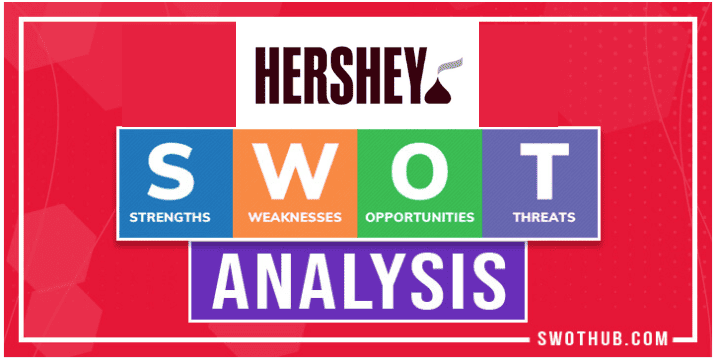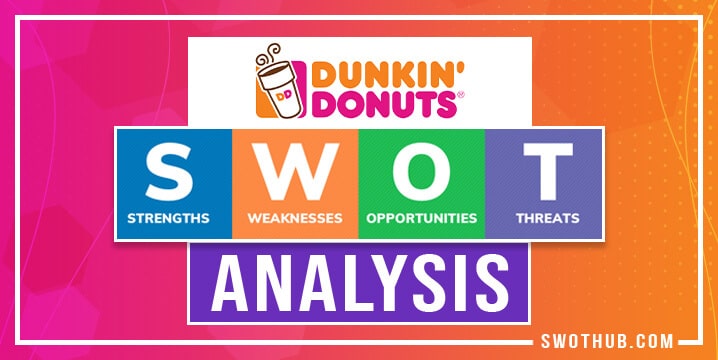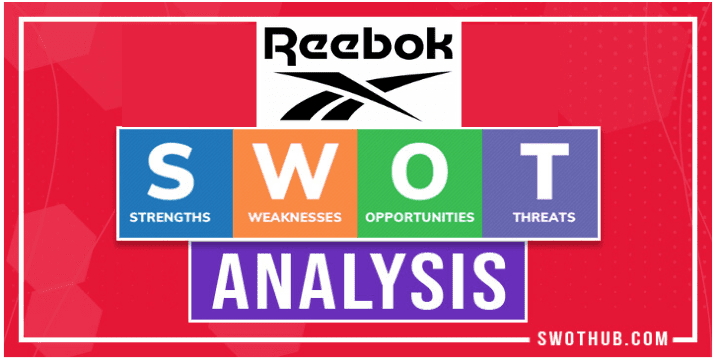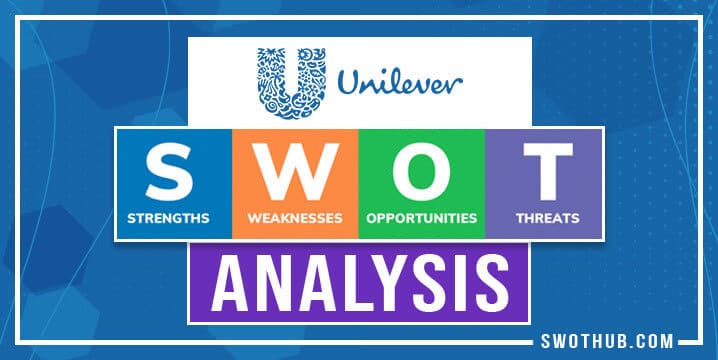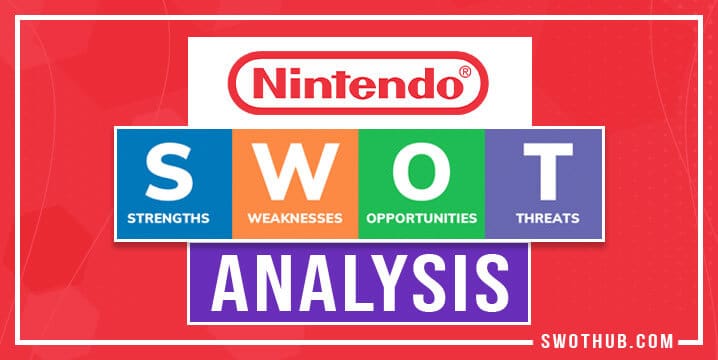If you are a chocolate lover, you know how the iconic Hershey Company has sweetened your life. In this Hershey SWOT analysis, we look at this iconic 1800s chocolate company that created an innovative chocolate bar that still leads the snacking industry in the candy business. Although iconic, Hershey has strong competitors such as Nestle, Mars Inc., and Cadbury, who are using their opportunities to gain market share. Let us look at Hershey’s strengths, weaknesses, opportunities, and threats in a SWOT analysis of Hershey.
Table of Contents
Hershey History
A renowned American manufacturer of chocolate with roots dating back to the late 19th century is Hershey. Milton S. Hershey established it in Derry Township, Pennsylvania, in 1894. Hershey’s innovation was the creation of a novel manufacturing procedure that made it possible to manufacture milk chocolate bars that were both economical and of good quality, an accomplishment that had previously been difficult to do. Due to this invention, Hershey was able to access the mass market for chocolate, which at the time was mostly a luxury good.
Hershey’s success had a big impact on the fiercely competitive business environment of the candy industry. First, Hershey was able to provide its products at cheaper prices thanks to economies of scale and mass production, making chocolate more affordable for the general population. This altered the market’s dynamics, which were formerly in the hands of pricey chocolate bars. Hershey gathered a large customer base and gained a competitive advantage by making chocolate affordable.
Hershey’s success encouraged other businesses to implement comparable mass production strategies and reduce their production procedures. As a result, the candy-making sector is now more competitive and racing to raise productivity and cut prices. As a result, to differentiate their products in an extremely competitive sector, chocolate and candy producers started to concentrate on innovation. The present candy industry was born out of Hershey’s success, where businesses always attempt to provide distinctive and alluring goods at reasonable prices.
Overall, the history of Hershey and its innovations in mass production and affordability changed the candy industry. Due to its innovations, the mass market for chocolate was created, the market dynamics were altered, and other businesses were inspired to use comparable manufacturing methods. In the very competitive candy sector, where businesses constantly innovate and meet consumer needs while aiming for cost-effectiveness, Hershey’s influence may still be seen today.
Hershey At-A-Glance
| Company | The Hershey Company |
| Industry | Snack Food, Candy |
| Founder | Milton S. Hershey |
| Year founded | 1894 |
| CEO | Michael Buck |
| Headquarters | Hershey, Pennsylvania |
| Number of employees | 16,620+ (2022) |
| Revenue (FY 2022) | US $10.42 Billion (2022) |
Hershey SWOT Analysis:
A SWOT analysis is a framework used to assess a company’s competitive situation and to create strategic planning. By taking Hershey’s strengths and weaknesses, as well as Hershey’s threats and opportunities, into account, we may better gain in-depth knowledge about Hershey’s company. In this article, we’ll be taking a look at Hershey’s SWOT framework to better understand its competitive position and potential for future growth. See how Hershey’s competitors fare against them and learn about Hershey’s strengths, weaknesses, opportunities, and threats.
Hershey SWOT Analysis Strengths:
The areas where a company excels above average or in a manner that distinguishes it from its rivals are its strengths. Hershey’s strengths are outlined in this SWOT analysis of Hershey, some of its strengths compared to competitors include:
One of Hershey’s strengths is its vast product lines. Take a look at Hershey’s most profitable products in the snacking and candy industry.
What products did Hershey make?
One of the company’s signature goods is the famous Hershey’s Milk Chocolate bar. The ingredients are a combination of cocoa, milk, and sugar, making it a traditional milk chocolate bar. Along with the traditional bar Hershey also manufactures:
- Kit-Kat Bars: As per a licensing deal with Nestlé, Hershey is in charge of producing and distributing Kit Kat in the US. All throughout the world, consumers like the well-known chocolate wafer bar known as Kit Kat.
- Reese’s: Hershey owns the well-known brand Reese’s. It is famous for its creamy peanut butter filling and chocolate-covered peanut butter cups. Other items from Reese’s include Reese’s Sticks, Reese’s Pieces, and Reese’s Miniatures.
- Twizzlers: The chewy candy Twizzlers come in a variety of tastes, including strawberry, cherry, and black licorice. They are long, twisted ropes.
Hershey is mostly recognized for its chocolate and candy goods, the business also creates several other types of snack foods. Hershey produces a variety of non-chocolate snack foods, such as:
- Hershey’s Snack Mix: Pretzels, nuts, and other chocolate sweets are all included in Hershey’s Snack Mix. Both savory and sweet snacks are available.
- Dipped Pretzels: twists that have been covered in a layer of Hershey’s chocolate are known as Hershey’s Dipped Pretzels. A delightful dessert is produced by mixing sweet chocolate with salty pretzels.
- Ice Breakers: Under Hershey’s umbrella, Ice Breakers is a breath-freshening product company. They sell a selection of fruity sour candies, chewing gum, and sugar-free mints.
- Jolly Rancher: Producing hard candies and lollipops in a range of fruit flavors, Jolly Rancher is another Hershey-owned brand. They are renowned for having a strong fruit flavor.
- PayDay: A well-known candy bar produced by Hershey, PayDay has a nougat center covered in a layer of caramel and peanuts.
- Krave Jerky: Krave Jerky is a company that specialized in premium, gourmet meat jerky, and it was also purchased by Hershey.
- SkinnyPop Popcorn: A healthier popcorn for the health-minded
Hershey’s Strengths continued:
Strong Brand Recognition: Consumers are very familiar with and loyal to the Hershey brand. The business has a long history and a solid reputation for making premium chocolates and candy items. Consumers are familiar with and rely on its recognizable brands, like Hershey’s, Reese’s, and Kisses.
Manufacturing Capabilities: Hershey can efficiently create and deliver its products on a large scale thanks to its strong manufacturing and distribution infrastructure. The company’s well-established supply chain and distribution network let it reach a wide range of consumers in various locations.
Strong North American Market Presence: Hershey holds a privileged position across the continent, particularly in the United States. The company has a competitive advantage over its rivals in the area thanks to its longstanding presence, extensive market penetration, and solid partnerships with retailers.
Product and Research Development: Hershey makes research and development investments to continuously innovate and create new goods. To stay relevant and seize market possibilities, the corporation adapts to shifting consumer trends and preferences by launching new tastes, variations, and package styles.
Corporate Social Responsibility: Hershey has shown a dedication to community participation programs, environmentally conscious business operations, and ethical cocoa sourcing. This commitment to social and environmental responsibility can improve the brand’s reputation and connect with customers who value moral behavior.
These strengths have kept this iconic candy manufacturer at the top of its competitors. Although Hershey does have several weaknesses.
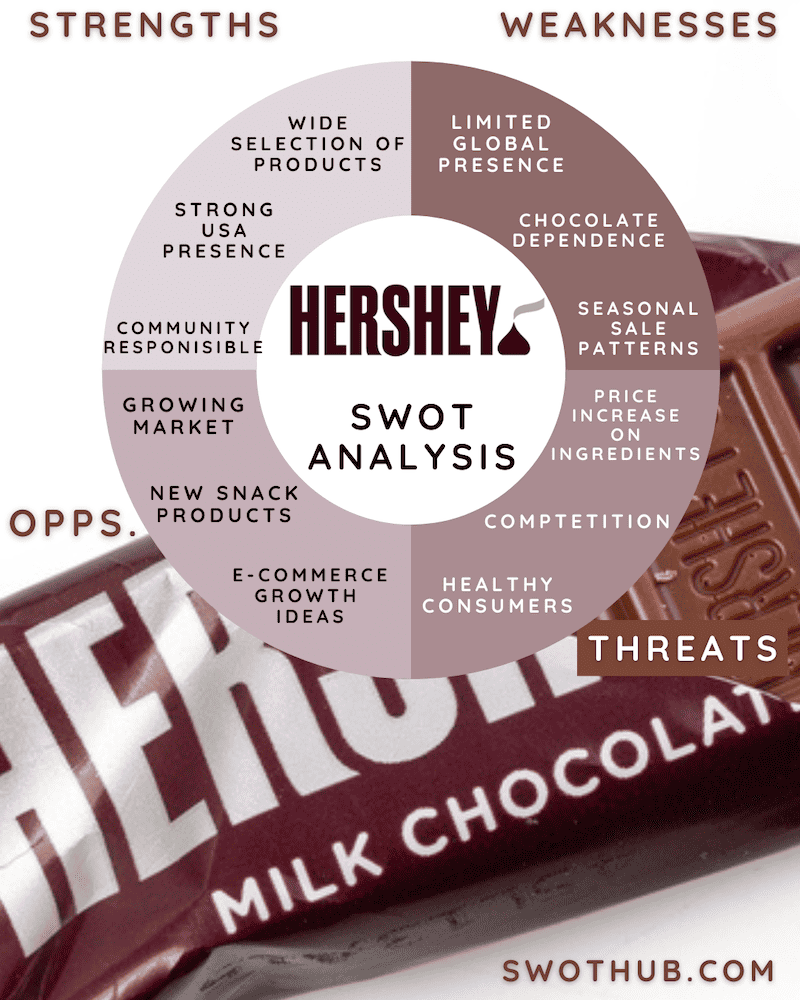
Hershey SWOT Analysis Weaknesses:
The weaknesses of a company are those that limit its potential, make it less competitive, and prevent it from achieving its goals. In this section of the Hershey SWOT analysis, we’ll look at Hershey’s weaknesses.
What is the weakness of the Hershey Company?
Limited Worldwide Market Presence: Hershey has a smaller overseas market footprint than some of its rivals, despite having a significant North American market presence. When trying to enter, grow, and compete on a global level, this could be a problem.
Dependence on Chocolate Products: Most of Hershey’s product line is made up of candy and chocolate products. Although this has historically been a strength, it may become a vulnerability if consumer preferences drastically shift in favor of healthier or alternative snack options. To meet shifting consumer needs and shifting market trends, Hershey may need to broaden its product line.
Seasonal sales patterns: Because of seasonal demand patterns, Hershey sees large changes in sales. For a sizable chunk of its annual revenue, the corporation is primarily dependent on the holiday seasons, such as Halloween and Christmas. Due to this, Hershey may be more susceptible to market turbulence, which may affect its sources of income outside of the season.
Price pressure due to competition: There are many companies seeking market share in the highly competitive candy industry. Price competition can be fierce, and Hershey might be under pressure to keep its prices low while juggling pressures from the cost of the ingredients, manufacturing, and distribution.
Potential Product Saturation: Hershey competes in a market with many suppliers of different chocolate and candy goods. There is a chance that the market may become overly crowded with comparable goods, increasing competition and possibly diluting the appeal of brands.
For a SWOT analysis of Hershey, for them to maintain and improve their competitive position, it may be essential to address these issues. Its products can be differentiated through innovation and marketing, growing its global footprint, diversifying its product offerings, managing seasonality, and applying effective pricing strategies, among other tactics, to help mitigate these disadvantages.
Hershey SWOT Analysis Opportunities:
Hershey has quite a few opportunities to make them thrive over their competitors. The following portion will examine some of Hershey’s opportunities compared to competitors, including:
Growing Global Chocolate Market: The global chocolate market is still expanding, particularly in emerging nations. Hershey can develop its international presence and enter these markets by leveraging its brand awareness and expertise to attract new customers and increase market share.
Increasing Healthier Consumers: In a Hershey SWOT analysis, as consumer awareness of health and wellness rises, Hershey may benefit from the desire for healthier and better-for-you snack options. Hershey can attract health-conscious consumers and differentiate itself in the market by producing and promoting items that appeal to these trends, such as low-sugar or organic alternatives.
E-Commerce Opportunities: The growth of e-commerce and direct-to-consumer platforms allows Hershey to reach out to customers directly, bypassing traditional retail channels. Hershey can expand its client reach and provide a seamless purchasing experience by investing in online platforms, tailored marketing, and efficient distribution.
Expansion into New Snack Products: Hershey can look into expanding its product offering beyond candy into adjacent snack categories. This could include acquisitions, collaborations, or internal product development to expand into areas such as salty snacks, nuts, or healthy snacks, diversifying its products, and appealing to a wider spectrum of consumer preferences.
If Hershey can use several of these opportunities against their competitors they can increase their appeal to consumers as well as grab a greater market share in the snack food industry.
Hershey SWOT Analysis Threats:
Threats pose a risk to every company’s stability and profitability. In this Hershey SWOT analysis, we will address some of the threats that are important to examine.
In a SWOT analysis of Hershey, some of its largest threats compared to competitors include:
Hershey’s Competitors:
the Hershey company SWOT analysis, its competitors would fall under the “threats” category. Here are some of Hershey’s main competitors in the candy and snack food industry. Many people ask:
Who was Hershey’s biggest competitor?
Several large businesses in the snack food and candy sectors compete with Hershey. Several of Hershey’s main rivals are:
- Mars, Inc.: Mars is a multinational candy manufacturer that creates well-known brands like M&M’s, Snickers, Milky Way, and Twix. Mars is a major player in the chocolate industry and directly competes with Hershey for market share.
- Nestlé: Nestlé is a global conglomerate of food and beverage companies that sells a variety of goods, including chocolate and confections. Among the many chocolate brands produced by Nestlé are Kit Kat, Crunch, Aero, and Smarties. Both domestically and abroad, Nestlé and Hershey are rivals.
- Cadbury, Toblerone, Milka, and Oreo: are just a few of the snack food brands owned by Mondelez International, a multinational corporation. Mondelez is more interested in international markets, yet Cadbury it is still a significant competitor to Hershey, especially in the chocolate sector.
- The Ferrero Group: In a Hershey SWOT analysis, The Ferrero Group is an Italian candy manufacturer best known for its lines of Ferrero Rocher, Kinder, Nutella, and Tic Tac. It still poses a threat to Hershey’s chocolate, even though it mostly competes in the premium chocolate and hazelnut spread areas.
- Lindt & Sprüngli: The Swiss chocolatier is well-known for its exquisite chocolates and truffles. Due to its reputation for producing high-quality chocolate, Lindt competes in the artisanal and premium chocolate markets, where Hershey also has a presence.
These brands are some of Hershey’s biggest competitors in the candy and snack sector, and they’re all striving for market share and consumer attention with a range of product offers, advertising techniques, and technological advancements.
Hershey’s Threats also include:
Changing Consumer Preferences: In a Hershey SWOT analysis, shifting consumer preferences and trends, such as increased demand for healthier snacks or alternative indulgences, can pose a threat to Hershey if it fails to adapt its product offerings accordingly. Failure to meet evolving consumer demands may result in losing market share to competitors who better cater to changing preferences.
Price Volatility of Key Ingredients: The price volatility of key ingredients like cocoa, milk, and sugar has an impact on Hershey’s business. Fluctuations in commodity prices can impact the company’s profitability and pricing strategies, affecting its ability to compete effectively.
Regulatory Environment for Candy and Snacks: The candy industry is subject to various regulations, including health and safety regulations, labeling requirements, and advertising restrictions. Compliance with changing regulations can pose challenges and potentially impact Hershey’s operations and marketing strategies.
SWOT Analysis of Hershey: Conclusion and Recommendations:
Hershey needs to focus on several key strategies to remain competitive in the snack foods and candy industry.
- Monitor Competitors and Market Trends: Keep an eye on what your competitors are doing, market trends, and evolving consumer preferences. To keep a competitive edge, do market research regularly, obtain consumer insights, and change plans accordingly.
- Embrace Digital Transformation: Invest in digital capabilities and e-commerce channels to improve the online shopping experience and directly engage consumers. Utilize data analytics and customized marketing methods to better understand consumer behavior and preferences.
- Focus on Health and Wellness: In a Hershey SWOT analysis, it should provide low-sugar, organic, or plant-based alternatives to meet the growing demand for healthier snack options. To address the requirements of health-conscious consumers, emphasize ingredient transparency, promote portion control, and provide nutritional information.
- Foster Innovation and Partnerships: Foster an innovative culture by investing in R&D skills to drive new product development and differentiate Hershey’s products. Seek strategic alliances or collaborations with startups, suppliers, or other industry participants to utilize knowledge, gain access to new technologies, and drive innovation.
FAQs for SWOT Analysis of Hershey
1. What is a weakness of the Hershey Company?
A notable weakness of the Hershey Company is its heavy reliance on the North American market. This geographic concentration potentially limits growth opportunities and increases vulnerability to regional market fluctuations and economic downturns.
2. What are the threats to the Hershey Company?
Key threats to Hershey include intense competition in the confectionery market, fluctuating raw material prices (especially cocoa and sugar), and changing consumer preferences towards healthier food options which may reduce demand for traditional chocolate products.
3. What are the competitive advantages of Hershey’s?
Hershey’s competitive advantages include a strong brand portfolio, a well-established distribution network, and a significant market share in the U.S. chocolate industry. Additionally, Hershey’s has a rich heritage and reputation for quality, enhancing customer loyalty and brand recognition.
By applying these suggestions, Hershey can portray itself as an innovative and customer-centric brand capable of satisfying consumers’ evolving expectations while remaining competitive in the volatile snack and candy sector.

